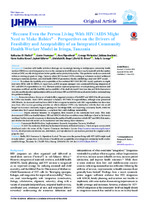| dc.contributor.author | Shelley, Katharine D. | |
| dc.contributor.author | Frumence, Gasto | |
| dc.contributor.author | Mpembeni, Rose | |
| dc.contributor.author | Mwinnyaa, George | |
| dc.contributor.author | Joachim, Juliana | |
| dc.contributor.author | Kisusi, Hawa Kadria | |
| dc.contributor.author | Killewo, Japhet | |
| dc.contributor.author | Baqui, Abdullah H. | |
| dc.contributor.author | Peters, David H. | |
| dc.contributor.author | George, Asha S. | |
| dc.date.accessioned | 2020-02-20T10:56:39Z | |
| dc.date.available | 2020-02-20T10:56:39Z | |
| dc.date.issued | 2019 | |
| dc.identifier.citation | Shelley, K. D., Frumence, G., Mpembeni, R., Mwinnyaa, G., Joachim, J., Kisusi, H. K., . . . George, A. S. (2019). “Because even the person living with HIV/AIDS might need to make babies” – perspectives on the drivers of feasibility and acceptability of an integrated community health worker model in iringa, tanzania. International Journal of Health Policy and Management, 8(9), 538-549. doi:10.15171/ijhpm.2019.38 | en_US |
| dc.identifier.issn | DOI: 10.15171/ijhpm.2019.38 | |
| dc.identifier.uri | http://hdl.handle.net/10566/5186 | |
| dc.description.abstract | Background: Countries with health workforce shortages are increasingly turning to multipurpose community health workers (CHWs) to extend integrated services to the community-level. However, there may be tradeoffs with the number of tasks a CHW can effectively perform before quality and/or productivity decline. This qualitative study was conducted within an existing program in Iringa, Tanzania where HIV-focused CHWs working as volunteers received additional training on maternal, newborn, and child health (MNCH) promotion, thereby establishing a dual role CHW model. Methods: To evaluate the feasibility and acceptability of the combined HIV/MNCH CHW model, qualitative in-depth interviews (IDIs) with 36 CHWs, 21 supervisors, and 10 program managers were conducted following integration of HIV and MNCH responsibilities (n = 67). Thematic analysis explored perspectives on task planning, prioritization and integration, workload, and the feasibility and acceptability of the dual role model. Interview data and field observations were also used to describe implementation differences between HIV and MNCH roles as a basis for further contextualizing the qualitative findings.
Results: Perspectives from a diverse set of stakeholders suggested provision of both HIV and MNCH health promotion by CHWs was feasible. Most CHWs attempted to balance HIV/MNCH responsibilities, although some prioritized MNCH tasks. An increased workload from MNCH did not appear to interfere with HIV responsibilities but drew time away from other income-generating activities on which volunteer CHWs rely. Satisfaction with the dual role model hinged on increased community respect, gaining new knowledge/skills, and improving community health, while the remuneration-level caused dissatisfaction, a complaint that could challenge sustainability. | en_US |
| dc.language.iso | en | en_US |
| dc.publisher | International Journal of Health Policy and Management | en_US |
| dc.subject | Community | en_US |
| dc.subject | Health Workers | en_US |
| dc.subject | Implementation Research | en_US |
| dc.subject | Integration | en_US |
| dc.subject | Tanzania | en_US |
| dc.title | “Because even the person living with HIV/AIDS might need to make babies” – Perspectives on the drivers of feasibility and acceptability of an integrated community health worker model in Iringa, Tanzania | en_US |
| dc.type | Article | en_US |

